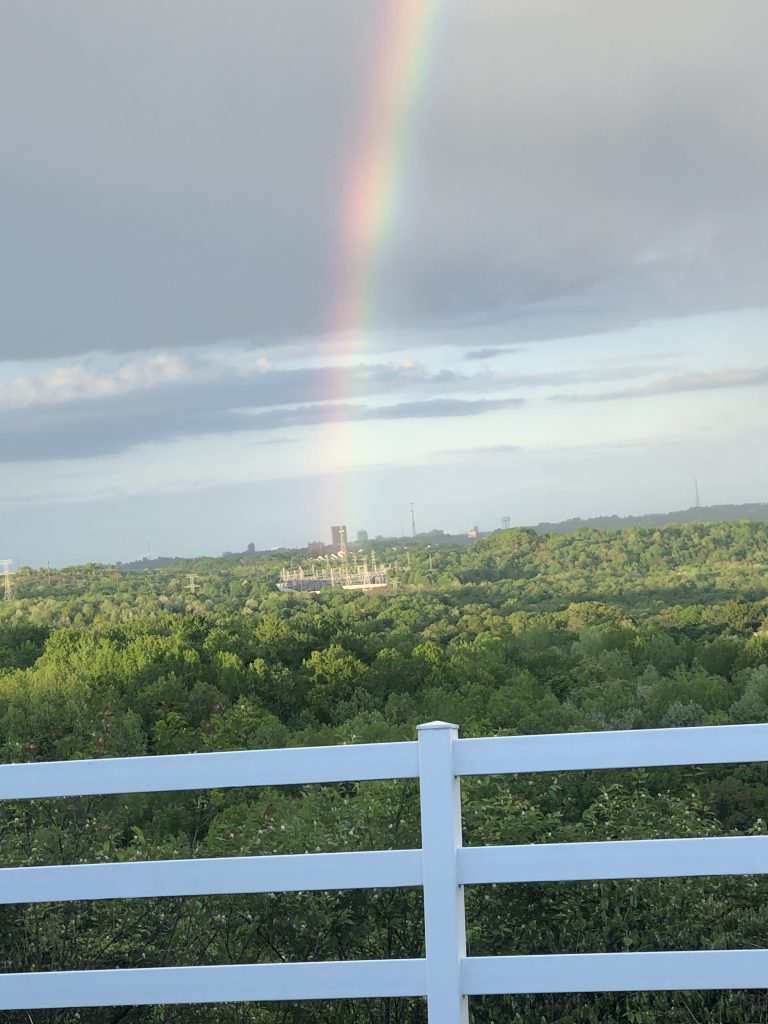 by Beth Dolinar, contributing writer
by Beth Dolinar, contributing writer
My home sits atop a hill I’ve come to call Mt. Crumpit, a nod to the mountain home upon which the Grinch snarled and planned his Christmas Eve plunder down below. While I’m not nearly that grumpy, I came up with the name because the weather up here can be grinchy.
The temperature will be balmy down below, but up here, it’s ten degrees colder and windy—often so blustery that my dog gets swept sideways on our morning walks. I didn’t think about the wind when I bought the place two years ago, because I was so taken by the view.
The back of my home faces a vast, green valley and at the far side of it stands the skyline of the city of Pittsburgh. Most prominent is the USX Tower, but I also can see the tops of other skyscrapers. At night, the city glows like a sparkly jewel in a deep velvet box.
Lately, the vista has been blocked by tall, weedy bushes that line the fence at the back of the property. The white fence stretches the length of the row of condominiums, and the weeds lurk behind the fence the whole way.
As rain fed the valley, the weeds sprung up overnight, adding feet to their height and width. Soon, I could no longer see the green valley, much less the city skyline.
I identified one of the taller plants as poison hemlock, a toxic shrub that, according to local legend, got a previous landscaper so sick with a rash he ended up in the emergency room. I put on a long-sleeve shirt and gloves, grabbed my hedge trimmers and went to climb through the fence to dispense with the invader.
I discovered I don’t live on a windy but gently-sloping hill but rather on a flat-topped cliff. On the other side of the fence is a slope that, if it were covered in snow, would be considered a black diamond ski slope. Unless I tethered myself to the fence (not sturdy enough) or rappelled down the hill, I would not be able to safely cut down the weeds. I Googled, “how to kill weeds from afar.” The answer was vinegar, but spraying that didn’t work. The poison hemlock seemed to laugh at me.
What is it about a vast, green view that is so compelling? Realtors say that houses with beautiful views can sell for tens of thousands of dollars more than those without. I don’t want to sell my house, I just want to look out across that valley, to scan the line where the sky meets the treetops. It’s calming to see clusters of early orange leaves in September rolling into the late-changing green ones. There are houses, and people, down in that valley, but I don’t see them—just maybe a light here or there. Some mornings I hear a rooster crowing from over the hill.
A view is fresh air for the eyes, a way to stand before something bigger than I am. We are used to seeing just small bits of the world; with a view we take in wide swaths of it.
Early this month, I woke to the sound of engines and looked outside to find a crew of workers at the other side of the fence. They were chopping down the weeds. I hope they were tethered to something.
By evening, the fence line was cleared. Unobstructed, the view of the valley was greener and more vast than ever, and the sky was festooned with clouds that looked like they were painted by Magritte.
As night fell, the clouds moved along and the city turned on her lights. They twinkled to me across the miles.
***
 About the author: Beth Dolinar is a writer, Emmy-award winning producer, and public speaker. She writes a popular column for the Washington “Observer-Reporter.” She is a contributing producer of documentary length programming for WQED-TV on a wide range of topics. Beth has a son and a daughter. She is an avid yoga devotee, cyclist and reader. Beth says she types like lightning but reads slowly — because she likes a really good sentence.
About the author: Beth Dolinar is a writer, Emmy-award winning producer, and public speaker. She writes a popular column for the Washington “Observer-Reporter.” She is a contributing producer of documentary length programming for WQED-TV on a wide range of topics. Beth has a son and a daughter. She is an avid yoga devotee, cyclist and reader. Beth says she types like lightning but reads slowly — because she likes a really good sentence.

